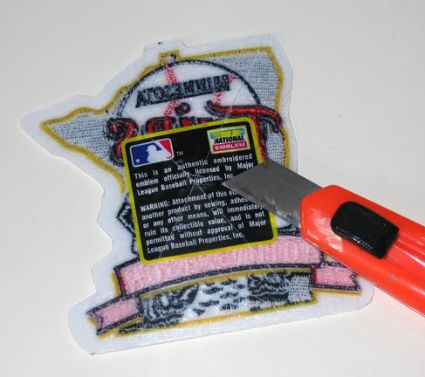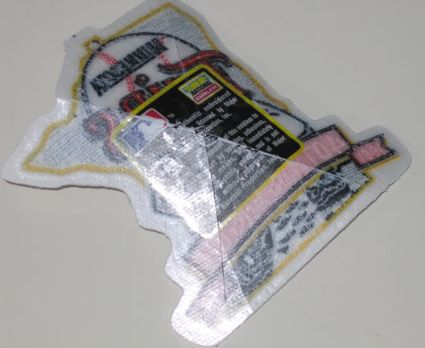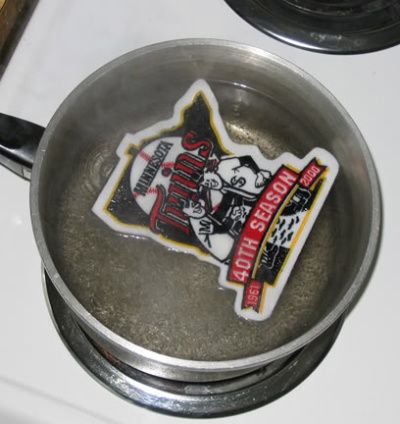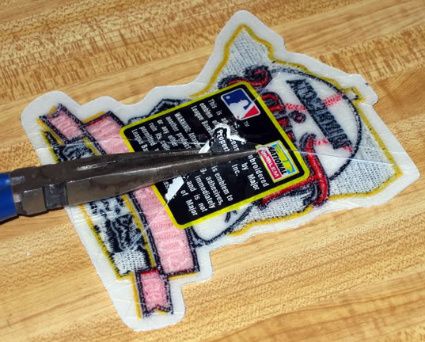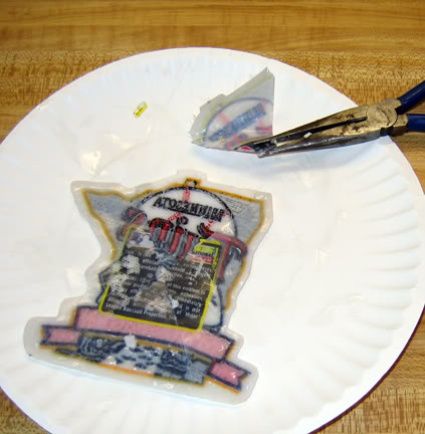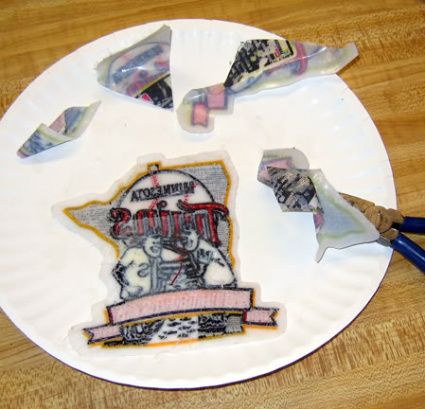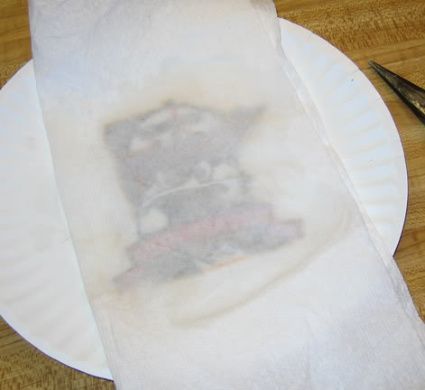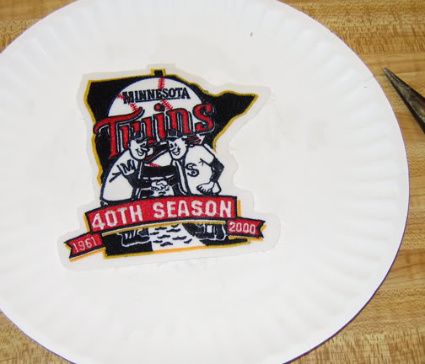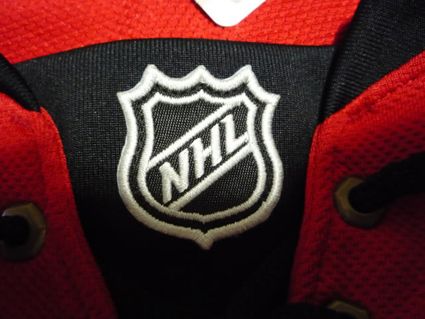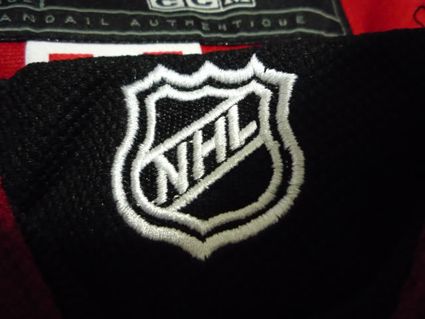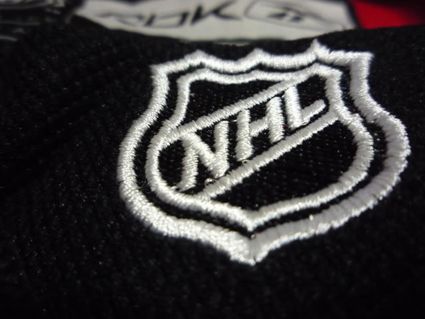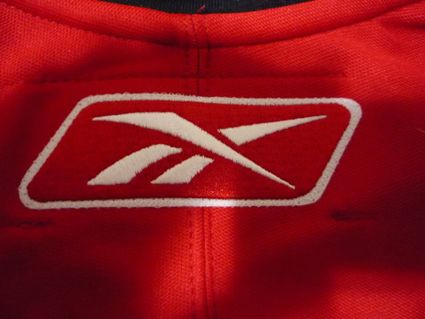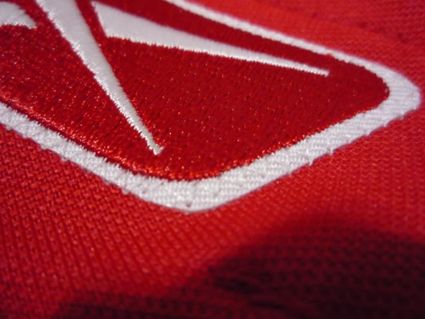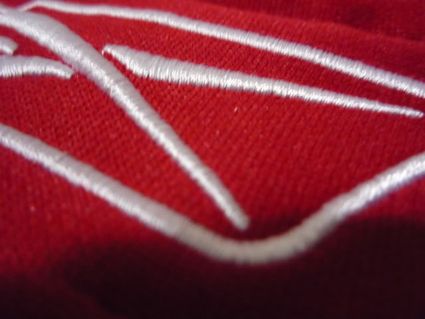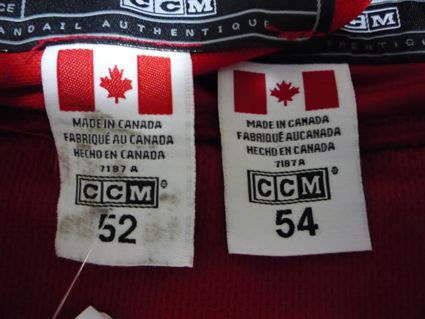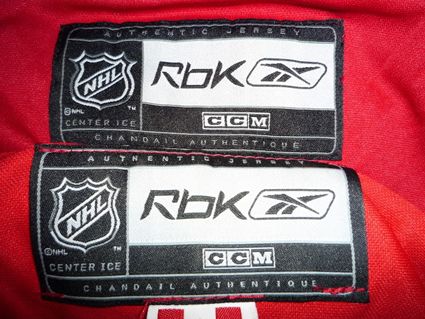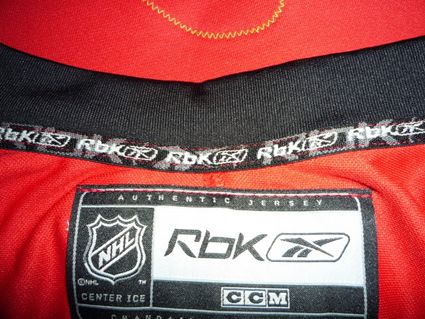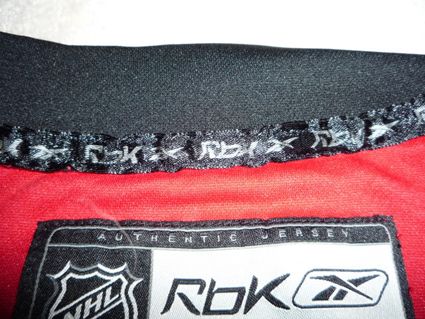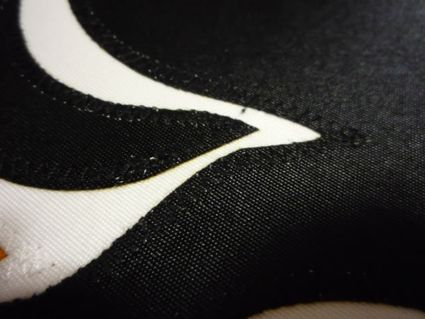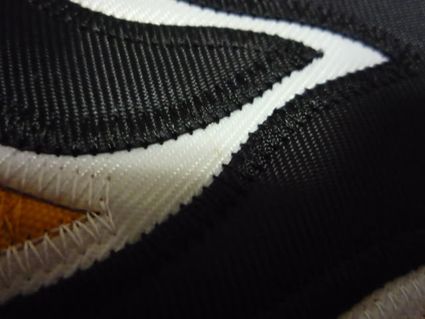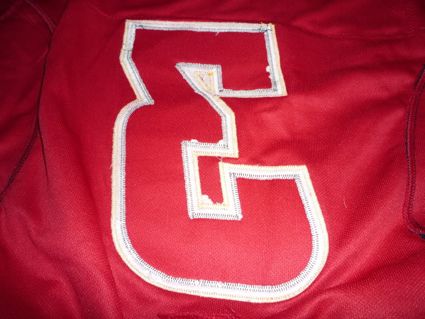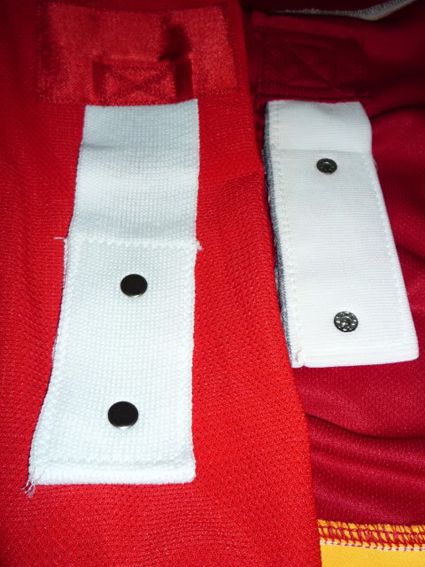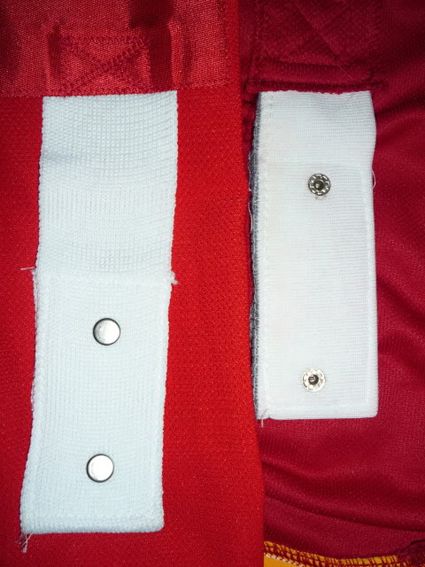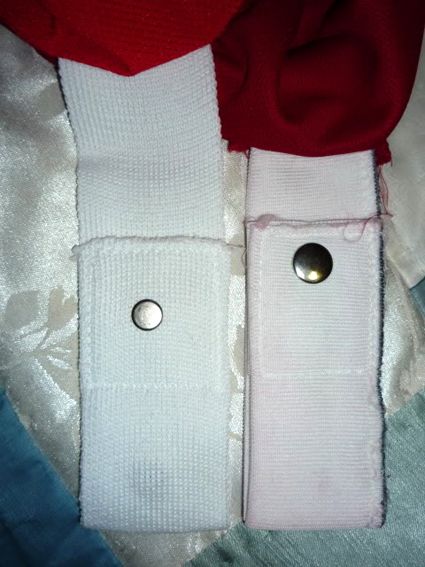Friday, September 16, 2011
Hockey Jersey Training Camp - Day 5 - Patch Resources
It's Day 5 of Hockey Jersey Training Camp and our next "drill" is about jersey patch resources and removing the rigid plastic backing from certain patches.
Beginning with the 1921-22 Ottawa Senators, who proudly proclaimed themselves as Champions of the World, the NHL has a long history of celebratory, anniversary, patriotic, anniversary of both city, team and even ownership, olympics games, memorial, charitable organizations, All-Star games, Stanley Cup Finals, arena openings and closings, special event games, such as the annual Hockey Hall of Fame game, season opening games in foreign countries and Winter Classic games, inaugural seasons and most recently jersey retirement ceremony patches.
The use of jersey patches was limited to Stanley Cup champions wearing a celebratory patches in the 1920's and did not reappear until the 1940's with a couple of patriotic examples followed by a patch worn by the Red Wings to commemorate the City of Detroit's 250th anniversary in 1950-51 and 1951-52.
Patches were non-existant for the remainder of the 1950's and all of the 1960's but when the Boston Bruins celebrated their 50th anniversary in 1973-74, the modern patch was born. In 1975-76, five of the Original Six clubs wore a patch for at least part of the season and the memorial patch came into being in 1977. Since then there has been at least one full season patch worn every season and their use exploded in popularity in the 1980's, kickstarted by the Edmonton Oilers wearing a different patch every year for four consecutive seasons from 1979-80 to 1982-83.
Here at ThirdStringGoalie there's nothing we like more than adding a patch to one of our jerseys. Of the over 450 non-game worn jerseys in our collection, 334 of them, or 72% have at least one additional patch added and we're frankly surprised the percentage is not higher. Of the 130 jerseys that do not have a patch, 68 are national team jerseys which tend to have far fewer patches than NHL jerseys, which frequently celebrate team anniversaries, hosting all-star games and Stanley Cup Finals appearances that don't apply to national teams.
There have even been occasions where we have first obtained a patch and then needed to get a jersey to go under it!
As with jerseys, a great number of our patches have come from ebay, due to the ability to find a great many of them for reasonable prices. There was a time when a little patience could turn up most anything you wanted and for a good price. Sometimes favorite sellers come and go, even reappearing again, although sometimes with the same inventory but a different user name.
One thing to be aware of though, is several sellers on ebay are selling reproductions of patches. In some cases they are making available patches which were never sold to the public or patches which are long out of production and we're please to finally be able to have a chance to purchase these. In other cases though, the same sellers are making copies of current, authentic patches which are readily available elsewhere. Normally, the majority patches do not have a finished edge and the design is surrounded by a quarter inch wide white border to allow for the stitching to attach the patch to the jersey. The copies have a very small raised edge around the outside of the patch the authentic ones do not.
While some demand only authentic patches from when they were originally produced, in many cases those were never or are now unavailable anywhere. At this point it becomes a matter of going without in the name of authenticity or getting the best patch available in this day and age.
This is especially true of memorial patches to honor those who have passed away. The teams do not want to risk being seen profiting from those who have died, and do not make memorial patches available to the public. But there is still a demand from collectors to own those patches to either honor the deceased, who have had a profound impact on their favorite club, or for the sake of making their jersey as accurate in appearance as possible for a given season or to simply add one to their jersey to make it stand out from the crowd. In the case of memorial patches, those who have the ability to reproduce such patches often waste little time in making them available via ebay, and it's up to the individual collector to decide if they want a known reproduction and if so, to decide which version available has the highest degree of accuracy, as some are much better than others.
Aside from ebay, one of our favorites is Patch Collectibles thanks to their great service and authentic products.
Another trusted source is Murf & Pat Denny Sports Memorabilia . Murf has been in the hobby since before it was a hobby and deals in only authentic patches as well. If it's hard to find, Murf is always a good bet to be the only one with it in stock. His prices can be higher at times, so it's not a bad idea to check out his ebay listings before buying direct from his website.
These days patches are manufactured by National Emblem, and it's possible to buy directly from the them, but you won't find anything vintage in nature.
If really backed into a corner, we will check out what's in stock at River City Sports. They seem to be either getting out of the patch business or cutting way, way back on inventory, as they only list a handful of patches after 2004 and their prices have been greatly slashed on their older ones. Be warned however, that we consider RCS to be a last resort, as their shipping prices are simply ludicrous. $15 shipping on a flimsy little patch is out of line and does not go over well with us in the least, especially when compared to a $2 shipping charge from Patch Collectibles.
Another source worth mentioning is Patch Collection, not to be confused with Patch Collectibles. We wish we could recommend them more, but they do sell quite a high percentage of modern remakes with the raised edge border we discussed earlier. The majority of the photos they use on their website and their ebay auctions are overexposed, making your ability to detect the remakes quite difficult, but there are some items they sell that are originals and they do carry some things we cannot find elsewhere, so we do on occasion purchase from them, especially via ebay.
If you have any recommendations for other sellers of patches, feel free to post your favorites in the comments below.
A development in the patch collecting world is the use of a hard plastic backing on patches made by National Emblem to prevent them from being sewn on a jersey. Furthermore, under the plastic is a warning sticker which reads "WARNING: Attachment of this emblem to another product by sewing, adhesives or any other means will ruin it's collectable value and is not permitted without the approval of the National Hockey League."
To be blunt, screw that.
They fail to mention how adding a patch will enhance the collectable value of the jersey to which it is applied.
Collectors have developed a number of different methods for removing the rigid, thick plastic backing, not to be confused with the thin flexible plastic coating long used to prevent fraying and the embroidery stitching from accidentally unravelling.
All three methods involve heating the patch in order to soften the adhesive and the plastic backing. The method we will illustrate here involves putting the patch in boiling water. The other options are heating the patch with a hair dryer or putting a paper towel over the patch and then placing a hot iron on it for 30-45 seconds.
Step 1 - First, read the warning label on the back and laugh at the part where it says putting the patch on a jersey will ruin it's value. Then, take a sharp knife and cut an "x" in the plastic, being careful to not cut all the way through the plastic and into the patch itself.
Step 2 - Fold the patch along the cuts to get the plastic to start to loosen from the patch.
Step 3 - Boil the patch. Ten minutes should get the job done. This is the step where you can also use an iron or a hairdryer as the heat source. Note: NEVER microwave a patch. With metallic threads becoming more commonly used, their presence will cause burn marks on patch within seconds, ruining your patch.
Using a fork will help keep the patch submerged, but is not essential.
Step 4 - Take a needle nose pliers and grab the point of one of the pieces of plastic and twist the plastic back on itself toward the outer edge of the patch. If you have boiled it long enough, you may even get a second piece off during this step.
Step 5 - Return the patch to the boiling water once it cools too much to get any more pieces off and, after another 5-10 minutes, repeat the removal steps by again grabbing the point of the plastic in the center of the patch and twisting if off towards the outer edge.
Step 6 - Once all the plastic is off, scrape off as much of the warning sticker that remains and blot the patch dry with a paper towel. I make a habit of putting it under a stack of books or heavy cardboard box to flatten it while it dries. Once this is done, your newly flexible (but now devoid of "collectible value") patch is ready to be sewn on any jersey, which will only increase the jersey's collectible value.
We've had pretty good results using both the boiling and iron methods, but have had an incident where the horizontal threads of the patch backing have stuck to the plastic backing and pulled out of the patch, ruining it. This was likely caused by not enough heat being used, but please understand this is not a foolproof method, but is widely accepted as the best way to remove the backing.
Labels:
Hockey Jersey Training Camp
Thursday, September 15, 2011
Hockey Jersey Training Camp - Day 4 - What to Put on Your Jersey
Day 4 of Hockey Jersey Training Camp brings us to our next "drill", what to put on your newly purchased jersey?
Obviously if you have just purchased a jersey that already has a name and number on it, you have little left to decide, but if you have acquired a blank jersey and want to have it customized with a player's name and number, you have quite a number of options, and there are several excellent resources to help you with your decision making process, and for us, this is where the fun of collecting really begins - researching the options available for a blank jersey.
It should be noted that while fans may choose to put their own name and number on a jersey to avoid the issue of choosing a player who will eventually no longer be on the team, sometimes sooner rather than later and sometimes under acrimonious circumstances, doing so will reduce the resale value of the jersey down the line to practically nothing and is something a collector usually avoids, as they are generally of the mindset that they are creating a "historical documentation" of a jersey worn on the ice.
The first thing to determine is when your particular jersey was worn. As long as it's an NHL jersey, there is no better place than The Hockey Uniform Database, formerly known as NHLUniforms.com. Here you will find every jersey worn by every NHL team, dating back to the league's founding in 1917.
You can view all the various club's jerseys from any given season or an overview of each jersey style worn by any certain team by clicking on the dates on the right or the icons on the left. For serious collectors, we recommend clicking through the various seasons and looking at your favorite club year by year. It's more work, but you will be rewarded with more detail, such as any additional patch worn on a club's jersey each season and any changes in manufacturer, as there was a number of them in the later 90's when Starter, Nike and ProPlayer joined CCM and took turns making the same style for several clubs. One thing to keep in mind is that each season the two Stanley Cup finalists since 1989 has worn a special patch on their jerseys, which will not be indicated here.
The basic white Mighty Ducks of Anaheim jersey was made by first CCM, then Nike, followed by ProPlayer before a return to CCM, only with the manufacturer logo now moved from the lower hem to up by the collar, and finally by Reebok! We must admit to being somewhat lax on the brand of jersey used on many of our replica jerseys as long as the style was the same, while others differentiate minor changes in branding style on the lower back from year to year on their authentic jerseys even though the manufacturer is the same.
Once you have narrowed your jersey style down to a time period of use acceptable to you, the next step is to figure out who wore that style. For that information we turn to HockeyDB.com, the Internet Hockey Database. There you can look up either player or team statistical histories, including all players for any given team in a given season. Search by team, and once you get to that team's information page, say the Detroit Red Wings for example, click "view all standings" and you will come to a page with the Red Wings record for each season of their existence, including a note on how far they made it in the playoffs. This is a quick way to make note of any Stanley Cup Finals appearances that you may want to consider commemorating. Click on any season on the left hand side, opening it in a new window, and you will get that year's Red Wings roster, the more current ones with roster numbers. Make note of any players you might be interested in having added to your jersey and repeat the process for each subsequent year your jersey was used.
EuroHockey.net is also helpful if you are looking for player info outside of North America, as is the "Past Tournaments" area of the history section of the International Ice Hockey Federation's website if your jersey is a national team jersey from a World Championship or Olympics since 2000.
We always add a patch to our jerseys whenever possible, so by going year by year through our jersey's lifespan on The Hockey Uniform Database helps us determine if any patches were worn on our jersey. If a patch can be added to our jersey, it helps to narrow down the number of years we have to sort through when trying to decide which players are eligible to be put on our jersey. NHLPatches.info is also an amazing resource for patch information.
At this point you should have a pretty good idea what season, patch and player options you have to pick from. Player choices are a very personal thing, and there are many reasons to choose who you want to permanently commit to your jersey. Some choose with an eye toward future resale value and only pick star players. Others choose their own favorite player, which are also often star players, but can also be players who scored a famous goal for a team, such as Stephane Matteau of the Rangers, a player they have met in person or any number of other reasons, such as a Conn Smythe, Hart, Art Ross or Vezina trophy winner, a team's leading scorer, someone who played for your local minor league team, a player with an unusual or very long name or the fact he wears your favorite number.
We also tend to favor team captain's or assistant captains in order to add the "C" or "A" to our jerseys. Every team's page on Wikipedia chronicles the history of their captains, but there are times when the captain is hurt and another player will wear the "C" during their absence. Finding out what your player options are for the "A" is an inexact science that requires some creativity and luck.
For occasional use of the "C" or wearers of the "A", we turn to GettyImages.com, starting with the editorial sport section. It does take some experience to learn how to do effective searching on Getty Images, and older pictures are often not labelled very accurately, especially with the correct date or even year, but there's more than enough on file here to answer your average question. Start by searching for the team you are interested in. Once you see you have an overwhelming more than 1000 pages of results, look for the search box in the upper left and select "search within", check that button and enter the year you are interested in, say 1999, and click "search". This will narrow it down to seven reasonable pages.
From there you can hover your cursor over the thumbnails to see them a bit larger, or click on them to open in a larger size. Hopefully among those photos you will find what you are looking for. For the 1999-00 season, we suggest one search for 1999 and another for 2000. You will soon learn the higher the number of the page, the older the photos are. Look for the dates the photos were taken to identify which season they are from. For example. page 7 of our search will likely be from 1998-99 and the 1999-00 season may not start until page 4.
Two other good sources for pictures of jerseys are Spirit of the Game, a dealer in game worn hockey jerseys who has numerous pictures of jerseys, mainly from 1970 to 2004, and Webshots.com, which seems to be the website of choice for jersey collectors to show off their collections. Other collectors use photo hosting sites such as Flickr.com and Photobucket.com as well.
Another option is to do a Google Image search for a player you suspect was an assistant, but those results will not be identified by year often, if at all. Hockey cards can also be of value in a search like this.
Armed with these resources, which are all in the right hand column of this page in the "Our Favorite Hockey Links" section, you should be able to educate yourself to what era your jersey is from, what your patch options may be, who played on the club during that time period and who may be eligible for a "C" or an "A".
At this point the rest is up to you to make the final decision on who you want to immortalize on your jersey and why. While some choices may be viewed as better than others, there are really no wrong answers, as long as you don't end up pictured in Puck Daddy's Jersey Fouls, that is!
Labels:
Hockey Jersey Training Camp
Wednesday, September 14, 2011
Hockey Jersey Training Camp - Day 3 - How to Spot a Fake
Hockey Jersey Training Camp continues with our third drill, and we are pleased to bring you a guide of what to look for in a fake jersey, reprinted here with kind permission of Tyler at NHLDigest.com.
Tyler begins:
Real:
Real:
Real:
As embarrassing as it is, over the past while several friends (and myself), have been duped into buying knock-off RBK Edge NHL jerseys.
Sometimes these jerseys can be easy to spot, but there are several companies that are making very good quality knock-off jerseys (typically manufactured in China or Korea).
After being bamboozled myself, I thought I’d go to some professionals for some tips and then write about it so you don’t make the same mistake that I did.
5 Things To Look For First:
- Does the web site look professional?When it comes to online shopping, your first impressions are important. If the site doesn’t look professionally designed, has poorly written content, or has a checkout process that is less than simple…be cautious.
- Does the site offer multiple methods to contact the company?A reputable website will always provide a full physical address on its contact page, as well as Telephone (toll-free is even better), and often live chat. In addition, they also may offer product reviews and site performance ratings to provide feedback from past satisfied customers. If all the site provides is a simple contact form or an email address, then it is likely that they don’t want you to find them too easily – for a reason!
- What types of shipping methods are used? If they don’t use one of the major North American courier companies such as UPS, FedEx, Purolator or US or Canada Post, then it is likely that your package is coming from very far away – if it comes at all.
- Where is the company based? If you do find a physical address (or other evidence) that the company is based offshore (especially Asia), then it is pretty much a sure bet that the jersey you are getting is a knock-off. All Reebok Authentic jerseys are manufactured in Canada, so there is no reason that a company in China would be selling Canadian-made authentic jerseys!
- Is the price too good to be true?If the listed price is significantly below the typical retail price, that should be an obvious warning flag. An Authentic Edge Jersey with real pro customization like will usually go for $350-$400USD, so if you see a seller advertising the same product for anywhere from $75 to $200USD, you can be sure you aren’t getting the real McCoy!
Inspecting The Jersey for Authenticity
The following are some key things about the jersey’s construction to look for. As mentioned, it’s been some time since the introduction of the RBK Edge jersey, and many fakes are now very close to being identical to the authentic so be very thorough in your investigation!
- The very first thing to note is the coloring of the jersey. Many knock-offs are good with the main colors of Black and White. However, you may be able to notice marked differences in Blues and Reds upon comparison to authentic jerseys.
- Check the logos and numbers for the correct detail. Again, the knock-offs are getting better at the detailing, but some NHL team logos have detail that can be hard to duplicate. Pay particular attention to the sizing and spacing of the letters and numbers on the jerseys. The letter and spacing are likely to be larger or smaller than the authentic version.
- Patches and stitching are also very important to compare. Compare the location of the stitching around the armpits and back of the neck to make sure the construction is authentic. In addition, the NHL and RBK trademarks on authentic jerseys are actually patches and not embroidery. This is one good comparison to make when shopping for a jersey on E-bay.
- I have used the fake Flames jersey that I bought on eBay, and compare it to my real authentic Flames jersey. Below are a few things that you can look for to determine whether the jersey you have on hand is in fact a real one. Now, in this experiment I am only using the "fake authentic" jersey that I bought on eBay to compare to a real one, and I am not certain whether this applies to replica ones (cause I don't collect replica jerseys). There are obviously quite a number of different manufacturers out there that manufacture fake jerseys. One jersey cannot speak for all of them, and with the popularity of Internet and communication, these manufacturers have "updated" the way their fake edge are designed and structured.
1) The Reebok logo and the NHL shield patch NHL Shield trademark
real:
fake:
Reebok trademark
Real:
Fake:
For all authentic, real Edge jerseys, the Reebok and the NHL shield trademarks are patches, which means they both need to be sewn onto a jersey. On my fake jersey, both trademarks are directly embroidered onto the jersey.
Also pay attention to how the Center Ice tag is sewn on to both jerseys. On the real jersey, it was only sewn on the entire top across, and only the corner of the bottom, whereas on the fake one the Center Ice tag was completely sewn on (the Reebok logo was surrounded by stitching completely). If the logos on your jersey are directly embroidered, then I’m sorry, your jersey is a fake.
Also pay attention to how the Center Ice tag is sewn on to both jerseys. On the real jersey, it was only sewn on the entire top across, and only the corner of the bottom, whereas on the fake one the Center Ice tag was completely sewn on (the Reebok logo was surrounded by stitching completely). If the logos on your jersey are directly embroidered, then I’m sorry, your jersey is a fake.
2) Neck tags (sz 52 is the real Edge, sz 54 is the fake one)
Surprisingly, both the size tag and the Reebok Center Ice tag are similar. But there are still a couple of things that could be found
a) The red stripe of the Canada flag are more wide compare to the real one, and the red maple leaf on the fake doesn't really look like a maple leaf. The gaps between letters on the real one is a bit wider compare to the fake
c) The Reebok Center Ice tags are almost identical, and the only difference you can tell is the "I" of the word "CENTER ICE" below the NHL logo (note that the bottom neck tag is from the real jersey)
a) The red stripe of the Canada flag are more wide compare to the real one, and the red maple leaf on the fake doesn't really look like a maple leaf. The gaps between letters on the real one is a bit wider compare to the fake
c) The Reebok Center Ice tags are almost identical, and the only difference you can tell is the "I" of the word "CENTER ICE" below the NHL logo (note that the bottom neck tag is from the real jersey)
3) Reebok stripe
Real:
Fake:
For real authentic jersey the Reebok stripe located above the Center Ice tag has the bigger Gray "RBK" wording behind, where there was none on my fake one. Now, as of Aug 22, 2009, I have spotted a few fakes on eBay that starting to have the bigger Gray "RBK" wording behind, so using this guideline to judge your jersey may not work anymore.
4) Twill and customization
Real:
Fake:
The tackle twill on the real jersey is completely different than that of a fake. The twill that the real one uses, and the ones that we most collectors uses to customize our jerseys, are came from Stahls'. The surfaces are virtually flat and smooth, and very light (aside from the glacier and dazzle twill). But on the fake one the twill are not flat and smooth at all, and are very hard and heavy for some reason.
Further, for some unknown reason there are backing papers behind the logo and the numbers. I do recall a couple of my early 90’s jerseys are customized this way. But this style of customization are seldom used. (TSG note: If you turn a legitimate jersey inside out, you will see only the zig-zag stitching, but fakes use a paper backing inside the jersey to prevent the fabric from tearing or otherwise getting holes in it while it is being sewn, similar to what is used on a sweatshirt with an embroidered design on it)
5) Fight strap (the one on the left is real)
Last but not least is the fight strap. Now, many fans, “rookie” collectors always have a mindset that a jersey with fight strap is authentic, or at least make it an authentic jersey, or even make it as a jersey that players worn on the ice. Well, an experience collector can tell you right away that “A JERSEY HAVING A FIGHT STRAP DOES NOT MAKE IT AUTHENTIC, AND DOES NOT MAKE IT TO BE THE SAME JERSEY THAT PLAYERS WORN ON THE ICE”! You could add a fight strap to a replica jersey easily, but that doesn’t mean the fight strap all of a sudden makes it an authentic jersey, or someone like to phrase it as “same jersey that players worn on the ice.”
Few notes on the fight strap:
a) All CCM, Reebok, or even Nike, you can only stretch the fight strap horizontally, not vertically. This is obviously to prevent the jersey from being pulled over one’s head during a fight. The fight strap on my fake jersey is very poorly constructed.The piece that attached the fight strap onto the jersey is tackle twill, and 99% of the time is the same colour as the jersey. It is sewn on with zig-zag stitching, with a cross stitching inside a small rectangle stitching, and a large rectangle sewn on around the twill using zig-zag stitching as well.
I just hope this information could help all fans and collectors. If you have additional information, please share it with all of us. Thanks in advance.
Happy collecting folks!!
Few notes on the fight strap:
a) All CCM, Reebok, or even Nike, you can only stretch the fight strap horizontally, not vertically. This is obviously to prevent the jersey from being pulled over one’s head during a fight. The fight strap on my fake jersey is very poorly constructed.The piece that attached the fight strap onto the jersey is tackle twill, and 99% of the time is the same colour as the jersey. It is sewn on with zig-zag stitching, with a cross stitching inside a small rectangle stitching, and a large rectangle sewn on around the twill using zig-zag stitching as well.
I just hope this information could help all fans and collectors. If you have additional information, please share it with all of us. Thanks in advance.
Happy collecting folks!!
*********************
Thanks again to Tyler for letting us reprint his excellent look at the detail differences between real and fake Reebok Edge jerseys. While there have been fake jerseys made of pre-Reebok jerseys, the proliferation of them, particularly on ebay and craigslist, really exploded with the arrival of Reebok as the sole NHL jersey supplier.
Points we'd like to further emphasize that apply to non-Reebok fakes are the use of shiny, wavy twill for the numbers when compared to the perfectly flat, less glossy twill used on legitimate jerseys. Quite often the fonts used for the numbers are too fat and the outlines too thin, if the font is even correct at all.
As for the online shops that spring up and disappear overnight only to spring up again with a new, similar name, it's pretty simple. If they do not provide a street address in the US or Canada, stay away from it. Read their "About us" or "Contact" pages and look for bad grammar and misspellings. Those are a dead giveaway that you are not dealing with a professional organization that uses English as their primary language of communication.
Labels:
Hockey Jersey Training Camp
Subscribe to:
Comments (Atom)

